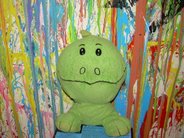So far in this blog I have only discussed the evidence for the existence of a mirror neuron system and its correlation to symptoms of autism, but what I have not yet discussed could possibly be the most important aspect; the reason the research has been conducted in the first place; finding a cure, or at least being able to further diagnosis and therapies for those suffering from the disorder. Due to the fact that these theories are fairly new and testing takes a great deal of time, only educated hypotheses can be made for possible treatments at this time, but I think it is important to include these possibilities into my research as the next steps to be taken in this field.
First, the possibility of early diagnosis comes from the EEG machine. In the experiment described in an earlier post, where EEG machines were used to detect the responses of the mirror neuron system to stimuli, the objects being detected were
 called Mu waves. A Mu wave is one of many Electromagnetic waves in the brain ranging from 8-13 Hertz. These Mu waves “arise from synchronous and coherent electrical activity of large groups of neurons in the human brain”. The waves are measurable with an electroencephalography or (EEG) machine. Many tests have been done observing the Mu waves with the EEG machine and it has been found that the Mu waves in the brain are suppressed when a person makes a voluntary movement. Also, it has been noted that the Mu waves are suppressed when watching someone else perform a task as well. In autistic individuals the mu waves are suppressed when doing an action, but not when seeing an action done. These findings suggest that EEG machines can be used to diagnose autism within weeks of birth. EEG machines pose no risk to infants, although it may be a little difficult to get a newborn to stop struggling long enough to put the cap on. Earlier diagnosis of autism means many things in the autism community. A few advantages of early diagnosis are early therapies and interventions and an understanding of the learning difficulties associated with autism. This could also mean great leaps forward in the way autism education is approached.
called Mu waves. A Mu wave is one of many Electromagnetic waves in the brain ranging from 8-13 Hertz. These Mu waves “arise from synchronous and coherent electrical activity of large groups of neurons in the human brain”. The waves are measurable with an electroencephalography or (EEG) machine. Many tests have been done observing the Mu waves with the EEG machine and it has been found that the Mu waves in the brain are suppressed when a person makes a voluntary movement. Also, it has been noted that the Mu waves are suppressed when watching someone else perform a task as well. In autistic individuals the mu waves are suppressed when doing an action, but not when seeing an action done. These findings suggest that EEG machines can be used to diagnose autism within weeks of birth. EEG machines pose no risk to infants, although it may be a little difficult to get a newborn to stop struggling long enough to put the cap on. Earlier diagnosis of autism means many things in the autism community. A few advantages of early diagnosis are early therapies and interventions and an understanding of the learning difficulties associated with autism. This could also mean great leaps forward in the way autism education is approached. There have been many suggested therapies with these new theories that could lead to better treatment options for autistic individuals as well. One such suggestion is biofeedback. Basically, biofeedback could be used to “used to display the mu waves and then use visual feedback of the display of the mu waves to teach children how to suppress the mu waves.” very little research has been published in this area, but still more is being conducted. The few published studies show very promising results with improvements in almost all areas using biofeedback.
Another possibility is correcting a chemical imbalance that may be disabling the mirror neuron system. Researchers believe that using certain neuromodulators could stimulate the mirror neurons that are associated with emotional responses; an area affected greatly in autism spectrum disorders. These along with many other innovative ideas are in testing right now and results seem to be very promising.
Works Cited:
“Mirror Neuron Theory”. Nov. 2006. 21 Feb. 2007
Olds, Jim. Krasnow Director's Column. 23 Oct.2006 . 26 Feb. 2007
What’s New in Neurofeedback. Kaiser,David. July. 2006. Vol. 9 No. 7 26 Feb. 2007.




No comments:
Post a Comment